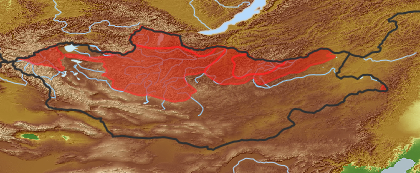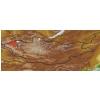| Class: | angiosperms |
| Order: | Ericales |
| Family: | Ericaceae |
| Genus: | Vaccinium |
| Scientific name: | Vaccinium vitis-idaea L. |
| Name acc. to: | Gubanov 1996 |
| Herbar: | list records   |
| Comments: | See also: http://www.manfred-vesper.de/datei.php?did=256 |
| Link to Flora of China: | http://www.efloras.org/browse.aspx?flora_id=2&name_str=Vaccinium+vitis-idaea |
| open map in a new window |  |
| Habitat: | Larch, cedarpine and mixed forests, goltzy in forest and alpine belts (Grubov 2001). |
| Habit (i)general appearance of a plant | |
| Growth form: (i)Herb, shrub, tree or climber. | shrub, subshrub or semishrub (i)Shrub, multi-stemmed, mostly (0.2) 0.5 - 5 m high, shoots woody up to the tip
example: Caragana leucophloea   inherited by family Ericaceae: shrub, subshrub or semishrub inherited by family Ericaceae: shrub, subshrub or semishrub
|
| Special growth forms or habits: | evergreen (i)Leaves remain on the plant in wintertime or in the dry season
example: Juniperus, Pinus, Ephedra
|
| Parasite status: (i)Is the plant a half- or full parasite? | no parasite/saprophyte (i)Plant fully autonomous, leaves with chlorophyll
example: Most plants, Ranunculus  inherited by family Ericaceae: no parasite/saprophyte inherited by family Ericaceae: no parasite/saprophyte
|
| Water or terrestrial plant: (i)Where do the plants grow? | terrestrial (i)Plant grows on dry land
example: Orostachys spinosa  inherited by family Ericaceae: terrestrial inherited by family Ericaceae: terrestrial
|
| Leaf (i)expanded, usually photosynthetic organ of a plant (including phylloclades) | |
| Leaf development: (i)Structure and development of leaves. | with green leaves (i)Plant with green leaves  inherited by family Ericaceae: with green leaves inherited by family Ericaceae: with green leaves
|
| Leaf arrangement: (i)Arrangement of leaves at the stem. | alternate (i)One leaf per node; distiche: arranged in two vertical rows, equitant
example: Phragmites    inherited by family Ericaceae: alternate inherited by family Ericaceae: alternate
|
| Simple or divided leaves: (i)Are the leaves simple or completely divided in several parts? Blade of the leaf entire or (more or less) deeply dissected. Attention: There are various appearances of the leaf margin (from entire to toothed and lobed). Here, we ignore this and ask only for dissections that separate the leaf for more than one third of its length or width, whatever is smaller. Sometimes, it is difficult to tell apart compound leaves from a shoot system with simple leaves: look for stipulae and/or axillary buds at the ground of the leaves: if only some possess these structures, the others are most likely leaflets of a compound leaf. | simple (i)Non-divided leaf, but margin may be incised nearly to the ground   inherited by family Ericaceae: simple inherited by family Ericaceae: simple
|
| Stipule: (i)Leaflets at the base of the petiole, these are smaller and of different shape. | none (i)Without stipules
example: Euphorbia, Ericaceae s.l.  inherited by family Ericaceae: none inherited by family Ericaceae: none
|
| Leaf colour upper side: (i)Shades of green on the leaf, upper side. | green (i)Clear green
example: Tribulus terrestris  inherited by family Ericaceae: green inherited by family Ericaceae: green
|
| Leaf colour lower side: (i)Shades of green on the leaf, lower side. | green (i)Clear green, in most species
example: Angelica decurrens  inherited by genus Vaccinium: green inherited by genus Vaccinium: green
|
| Leaf veination: (i)Arrangement of the main veins of a leaf. | pinnate (i)One main vein, several side veins, sometimes inconspicuous
example: Cicerbita     inherited by family Ericaceae: pinnate inherited by family Ericaceae: pinnate
|
| Flower (i)reproductive portion of the plant, consisting of sepals, petals, stamens, and pistils | |
| Flower appearance and pollination: (i)General appearance of the flower. | attractive, animal-pollinated (i)attractive and coloured flowers, mostly large, attracting surely animals
example: Trollius, Rosa, Chamaerhodos  inherited by family Ericaceae: attractive, animal-pollinated inherited by family Ericaceae: attractive, animal-pollinated
|
| Perianth arrangement: (i)Attention: in some plants, flowers may be dimorphic in different ways (dioecious or gynodioecious). If flowers vary, record the characters of the most showy flowers. | double, different (i)Two types of perianth leaves, differently coloured (sepals: outer periant leaves, usually greenish, and petals: inner perianth leaves, usually coloured)
example: Parnassia    inherited by family Ericaceae: double, different inherited by family Ericaceae: double, different
|
| Flower symmetry: (i)Symmetry of the perianth leaves. Attention: to assess this character, look on sepals, petals and stamens, but neglect carpels and ovary. | radiary, regular (actinomorphic) (i)More than two axis of symmetry
example: Saxifraga: 5; Iris: 3   inherited by family Ericaceae: radiary, regular (actinomorphic) inherited by family Ericaceae: radiary, regular (actinomorphic)
|
| Sepal number: (i)Number of sepal leaves (outer perianth leaves, calyx leaves, mostly greenish). Attention, this character applies only for flowers separated in sepals and petals, thus excluding most monocots. Be aware of the bracts (involucral leaves) of Asteraceae flowerheads, do not qualify these as sepals! Be also aware in Rosaceae is often an epicalyx developed, in this case count all parts. | 5 (i)
example: Polemonium  inherited by family Ericaceae: 5 inherited by family Ericaceae: 5
|
| Sepal fusion: (i)To which degree are the sepal leaves connected? Attention, this character applies only for flowers separated in sepals and petals, thus excluding most monocots. Be aware of the bracts (involucral leaves) of Asteraceae flowerheads, do not qualify these as sepals! | free (i)All leaves separate from each other
example: Geranium  inherited by family Ericaceae: free inherited by family Ericaceae: free
|
| Petal / Tepal number: (i)Number of petal leaves (inner perianth leaves, usually coloured). | 5 (i)
example: Potentilla  inherited by family Ericaceae: 5 inherited by family Ericaceae: 5
|
| Petal / Tepal fusion: (i)To which degree are the petal leaves connected? Petals sympetalous. | fused (i)petal leaves united, only tips are free (gamopetalous, sympetalous)
example: Linnaea, Adenophora, Stellera  inherited by family Ericaceae: fused inherited by family Ericaceae: fused
|
| Spur: (i)A hollow, slender, sac-like appendage of the perianth leaves, storing nectar. | no spur (i)Flower without appendage
example: Peganum  inherited by family Ericaceae: no spur inherited by family Ericaceae: no spur
|
| Stamen number: (i)Attention: We ask for the reproductive organs of the flower dispersing pollen. Count only fully fertile stamens, not staminodia (e.g. Parnassia). | 10 (i)
example: Silene  inherited by family Ericaceae: 10 inherited by family Ericaceae: 10
|
| Stamen fusion: (i)To which degree are the stamens fused? Attention: Whereas the pollen sacs itself are often free., their stalks (filaments) may be fused. Here, we count them as fused if they are together over at least one thirth of their length. | free (i)Stamens with separate bases
example: Malus  inherited by family Ericaceae: free inherited by family Ericaceae: free
|
| Pistil number: (i)Number of pistils (female floral organs: style, if developed; stigma and carpels/ovary together build the pistil). | 1 (i)One carpel, but clearly one stigma
example: Pyrola, Primula, Alyssum  inherited by family Ericaceae: 1 inherited by family Ericaceae: 1
|
| Carpel number: (i)Number of carpels (carpel: forming a simple pistil or part of a compound pistil, modified leaf). | 5  inherited by family Ericaceae: 5 inherited by family Ericaceae: 5
|
| Carpel fusion: (i)To which degree are the carpels (modified leaf forming simple pistil or part of a compound pistil) fused. | fused (i)Carpels united into an ovary, only styles are free
example: Malus, Berberis  inherited by family Ericaceae: fused inherited by family Ericaceae: fused
|
| Style number: (i)Portion of the pistil connecting the stigma to the ovary. | 1  inherited by family Ericaceae: 1 inherited by family Ericaceae: 1
|
| Ovary position: (i)For entirely or partly fused carpels, describe their position in relation to the insertion point of perianth leaves (best done by doing a longitudinal section of a flower). | inferior (i)Ovary below the point where perianth leaves are inserted, always fused to an ovary
example: Vaccinum    inherited by genus Vaccinium: inferior inherited by genus Vaccinium: inferior
|
| Sex: (i)Distribution of male and female organs among flowers, only most commonly cases. | bisexual, hermaphrodite (i)All or nearly all flowers of a plant with male and female parts
example: Haplophyllum, Chenopodium  inherited by family Ericaceae: bisexual, hermaphrodite inherited by family Ericaceae: bisexual, hermaphrodite
|
| Fruit (i)the seed bearing organ, with or without adnate parts; a ripened ovary and any other structures which are attached and ripen with it. Aggregate fruits are handled like simple fruits for determination. | |
| Consistency: (i)Fleshy fruits or dry fruits, see dispersal adaptations for further classification. | fleshy (i)Usually non dehiscent; with a fleshy (swollen because of a high water content) outer shell, flesh edible at least for animals
example: Prunus, Amygdalus, Malus  inherited by genus Vaccinium: fleshy inherited by genus Vaccinium: fleshy
|
| Type of fruit: (i)Common fruit types (including pseudocarp). | Indehiscent fruits  inherited by genus Vaccinium: Indehiscent fruits inherited by genus Vaccinium: Indehiscent fruits
Solitary fruits (i)     inherited by genus Vaccinium: Solitary fruits inherited by genus Vaccinium: Solitary fruits
berry (i)Fleshy fruit with several to many seeds in the flesh
example: Tomato   inherited by genus Vaccinium: berry inherited by genus Vaccinium: berry
|
| Opening of fruit: (i)Mode of dehiscence at maturity to release seeds. | not opening / indehiscent (i)Fruits remain closed at maturity and disperse with seeds inside
example: Corylus (nut), Vaccinium (berry)  inherited by genus Vaccinium: not opening / indehiscent inherited by genus Vaccinium: not opening / indehiscent
|
| Size of fruit: (i)Size of the fruit including appendage. | from 5 mm to 10 mm (i)
example: Silene: small capsule opening with teeth  inherited by genus Vaccinium: inherited by genus Vaccinium:
|
| Dispersal: (i)Appearance of fruit or seed (if single) and adaptations to dispersal. | Fleshy, edible (i)At least parts with a soft tissue edible at least for some animals (not necessarily for humans)  inherited by genus Vaccinium: Fleshy, edible inherited by genus Vaccinium: Fleshy, edible
|
| Root / shoot below ground (i)plant part below ground (in most cases), including below ground shoots, without leaves | |
| Root type: (i)Organisation of the roots. | allorhizous (i)Plant with a conspicuous tap root, one larger tap root with side roots
example: Dicotyledonae  inherited by order Ericales: allorhizous inherited by order Ericales: allorhizous
|
| Distribution (i)region where the plant is likely to be found | |
| Distribution (Veg. Zones): (i)acc. to Grubov 1952 | Khubsgul (i)In distribution data often named as '1' 
Khentei (i)In distribution data often named as '2' 
Khangai (i)In distribution data often named as '3' 
Mongol-Daurian (i)In distribution data often named as '4' 
Great Khingan (i)In distribution data often named as '5' 
Khobdo (i)In distribution data often named as '6' 
acc. to: Gubanov 1996 |
| Distribution Khangay: (i)acc. Flora Khangaya 1989 | I
II
III
IV
V
|
| Plant Use | |
| Medical Plant Use: (i)Only if plant is used as medical plant | Use: Both the leaves and fruit are useful for treating congestion or the common cold or liver kidney and urethral ailments. Berries are a good source of Vitamin C, A, and is rich in antioxidants and are used for raising blood pressure and in diabetics. Mongolians use extracts of the leaves and fruit for treatment of cold and improving immunity in winter season. (considered medicinal value in Mongolia acc. to Makkar et al 2009) (i)Medical use in eastern and western medicine
|
| General Use: | medical plant
|
| Plant Status | |
| Local Names: | local names: Anis, alirs (acc. to Makkar 2009)
|